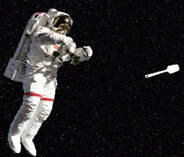
Although one’s respect for the environment and for other people may vary between cultures and between individuals within cultures, humans, as a whole, haven’t been an outstanding example of cleaning up after themselves. No matter when or where they go, there is always evidence of their presence left behind. The same is true in space.
◄Photo Source: http://www.lushforlife.com/2006/07/spatula-crisis-strikes-nasa/
Over the past sixty or seventy years plus we have been sending things into space, a more-or-less undefined boundary somewhere out there around a thousand miles from earth’s sea level. As we ventured into the unknown to meet the last frontier, we’ve left behind a trail of all kinds and sizes of space zombies.
Not the science fiction kind of space zombie but real junk… dead articles and pieces of things which once had a life, now left behind either by accident or necessity. Image Credit: NASA JPL- Apollo 17, December 1972: Blue Marble
Photo Source: esa.int/ESA_Multimedia/Videos/2019/space_debris_in_orbit
NASA doesn’t know exactly what’s up there, and many smaller items will die a fiery death as they fall through the atmosphere, but the scientists believe 95% of the objects are leftovers or inoperative satellites.
As far as how many objects, in 2019 the US Space Surveillance Network reported nearly 20,000 artificial objects in orbit above the Earth, including 2,218 operational satellites and natural space debris. These are large enough to be tracked. According to Wikipedia, in the same year, “more than 128 million pieces of debris smaller than 1 cm (0.4 in), about 900,000 pieces of debris 1–10 cm, and around 34,000 of pieces larger than 10 cm were estimated to be in orbit around the Earth.” en.wikipedia.org/Space_debris
| Image Credit: NASA - Photo ID: STS088-724-66 Source of Photos: Wikipedia | 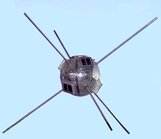 ◄To the left is a drifting thermal blanket photo-graphed in 1998 during STS-88. ►In 1958, the US launched Vanguard I into a medium Earth orbit. According to Wiki-pedia, as of October 2009, it, and the upper stage of its launch rocket, are the oldest surviving human-made space objects still in Image Credit: NASA photo retouched orbit. National Space Science Data Center |
Image credit: NASA - Photo Source: www.nature.com/d41586-018-06170-1
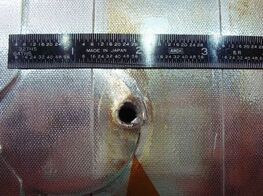
Astronomers and others have worried about space junk since the 1960s, and today the space agencies take space zombies very seriously as a hazard to active satellites and spacecraft. It has been theorized that Earth orbit could even become impassable if the risk of collision grows too high. There have been many near and actual collisions, although they may not hit the news media, and as the amount of junk increases, so do the risks.
SPACE-TRAFFIC MANAGEMENT
Space-traffic management is a new field in its infancy. Specifically targeting management of space debris, the problem is being approached from a variety of directions by scientists. The current strategy is one of evasive action in actual space, i.e. maneuvering to nudge objects out of the way by various methods to avoid collisions.
Although there are agencies and government departments in several nations addressing this issue, the topic hasn’t risen to the level of political intervention; i.e. it hasn’t become politically “sexy”. Hopefully, the scientists and related industries involved will be left alone long enough to accomplish something. Currently, areas of feasibility study and experimentation include some of the following:
● Better Tracking Of Debris Location
Some scientists are tackling the problem of space junk by trying to understand where all the debris is to a high degree of precision, accurately enough to avoid the need for touchy maneuvers in space. Unfortunately, we aren’t able to identify what every piece of debris is or where it is.
● Better Tracking Of What Debris Is Made Of
Once researchers know what an orbiting object is made of, they often have several potential ways to reduce its threat. Some methods can force objects into the atmosphere to burn up or into less heavily trafficked orbits called graveyard orbits.
● RemoveDEBRIS Remediation Technology
RemoveDEBRIS is a satellite research project intended to demonstrate various space debris removal technologies. It is the only project presently being tested in space. The space craft -- launched in June, 2018, from a SpaceX rocket and activated through the Internation Space Station -- to hone in on a cluster of debris in orbit and release a wide net of Remove Debris modules using robotic net and harpoon tethering technologies, laser beams and eledtrodynamic tethers.
● Space Debris Elimination Project
This NASA program proposes shooting atmospheric gasses into space to destabilize the debris' orbit and send it plummeting back to Earth, where it will burn up in our atmosphere. This proposal presented questions about the potential increase in carbon emissions in the atmosphere.
NO INTERNATIONAL TREATY
So far, no international treaty for minimizing space debris [Personally, I like space zombies better] has been negotiated. A set of voluntary guidelines was published in 2007 by the United Nations Committee on the Peaceful Uses of Outer Space (COPUOS) based on earlier attempts to negotiate a treaty. Based on current political trends, I’d wager that it will be a long time in coming.
LOST IN SPACE
The most entertaining part of this research was an article written by Clara Moskowitz entitled “Lost in Space: 8 Weird Pieces of Space Junk” and published on February 13, 2013 by wired.com/2009/02/spacestuff/. This list of articles lost in space and part of our space zombies in the sky. I’ve summarized, but this is entirely Moskowitz’ work.
● "Spatula
While spreading some goo as a test of heat-shield repair materials, spacewalking astronaut Piers Sellers accidentally lost a spatula he had been using. The mishap took place during the space shuttle Discovery's 2006 STS-121 flight to the International Space Station, on a mission to test new safety techniques after the 2003 Columbia disaster. "That was my favorite spatch," Sellers reportedly said. "Don’t tell the other spatulas."
outube.com/watch?v=QYS4HrMji8U&feature=youtu.be
● “Tool bag
Astronaut Heide Stefanyshyn-Piper lost her grip on a tool bag while doing a spacewalk in November 2008 to try to repair a jammed gear on a space-station solar panel. The 30-pound bag, filled with grease guns, a scraper tool and a couple of bags for debris, cost about $100,000. Amateur astronomers spotted subsequently spotted the bag in orbit. Watch the bag float away below. http://www.spaceweather.com/flybys/?PHPSESSID=v5r9ilmkqgek0vcqoq2svcenr2
● “Tank of ammonia
This one was lost on purpose. In July 2007, NASA instructed astronauts to throw an unneeded 1,400-pound tank full of ammonia overboard. The device used to be part of the space station's cooling system, but when the A/C was upgraded, it became obsolete. Deeming that it would take up too much cargo room to carry it back to Earth, mission managers decided to have it trashed. More than a year later, the tank burned up over the South Pacific Ocean as it hit the atmosphere.”
● “Gene Roddenberry's ashes
A portion of the ashes of Gene Roddenberry, creator of the Star Trek series, were delivered to space in 1992 by the space shuttle Columbia on its STS-52 mission. The lipstick-sized capsule containing his ashes orbited the Earth before eventually disintegrating in the atmosphere.”
● “Pee
Over the years, most of the urine produced by astronauts has been simply dumped overboard. Once pee hits the cold vacuum of space, it quickly freezes into tiny crystals which then float around as debris. (Astronauts have described watching urine being released into space as one of the most beautiful sights in orbit). Recently, however, a new pee-recycling system was brought up to the International Space Station to turn urine into drinking water, cutting down on the pee debris.”
● “Pliers
While repairing a damaged solar array during a November 2007 spacewalk, astronaut Scott Parazynski accidentally lost a set of needle-nose pliers, which were spotted floating away below the station.”
● “Camera
Astronaut Suni Williams was tussling with a stuck solar array on the space station in June 2007 when her camera came untethered and drifted away. Rather than astronaut error, this incident may have been caused when the button holding down the camera broke. Watch video of the mishap below.
https://www.youtube.com/watch?v=fTBFlSwtBKc&feature=emb_title
LARGEST EVER
The largest space zombie known so far was a Chinese rocket that eventually took its last gasp of atmosphere and landed in the Atlantic Ocean on May 11, 2020. The rocket’s empty core stage, weighing nearly 18 tons, is the largest piece of space debris to fall uncontrolled back to Earth since 1991. And by the way, on the way to its final resting place, the rocket core flew over Los Angeles and New York.
It’s a good thing we have a lot of people tracking this kind of event.
Just sayin’.
□‘
Sources:
https://www.dailystar.co.uk/news/latest-news/615172/space-flashes-earth-satellite-photo-explanation-science
https://www.nasa.gov/mission_pages/station/news/orbital_debris.html
https://www.esa.int/ESA_Multimedia/Videos/2019/02/Distribution_of_space_debris_in_orbit_around_Earth
https://medium.com/@zeel.patel/space-debris-in-the-21st-century-3a51a8cd87f
https://www.smithsonianmag.com/smart-news/forgotten-piece-space-junk-headed-earth-180957072/
https://iannuccihistory.weebly.com/class-blog/scientist-want-to-clean-up-space
https://phys.org/news/2019-05-space-sustainability-aims-amount-debris.html
https://phys.org/news/2018-09-image-small-satellite-solution-space.htm
https://phys.org/news/2018-09-video-net-successfully-snares-space.html
https://en.wikipedia.org/wiki/Space_debris
https://archive.epa.gov/epawaste/nonhaz/municipal/web/html/
https://www.epa.gov/facts-and-figures-about-materials-waste-and-recycling/national-overview-facts-and-figures-materials#:~:text=The%20total%20generation%20of%20municipal,27%20million%20tons%20were%20composted.
https://www.technewsworld.com/story/86542.htmlhttps://www.esa.int/ESA_Multimedia/Videos/2019/02/Distribution_of_space_debris_in_orbit_around_Earth
https://www.nature.com/articles/d41586-018-06170-1
https://www.popularmechanics.com/space/a26885/space-junk-cleanup/
https://www.scientificamerican.com/article/the-quest-to-conquer-earths-space-junk-problem/#:~:text=The%20space%20around%20Earth%20is,or%20pieces%20of%20inactive%20ones.&text=To%20assess%20the%20risk%20of,little%20information%20about%20many%20items.
https://www.businessinsider.com/where-does-space-begin-2016-7
https://www.wired.com/2009/02/spacestuff/
https://www.businessinsider.com/how-nasa-astronauts-pee-and-poop-in-space-2018-8
https://www.cnbc.com/2020/05/16/chinese-rocket-falls-to-earth-space-debris-problem-worsens.html#:~:text=A%20Chinese%20rocket%20that%20became,back%20to%20Eart
Photos Only
https://airandspace.si.edu/exhibitions/outside-the-spacecraft/online/floating.cfm
https://www.celestis.com/blog/countdown-to-celestis-16-the-heritage-flight/
http://www.lushforlife.com/2006/07/spatula-crisis-strikes-nasa/
http://www.spaceweather.com/flybys/?PHPSESSID=v5r9ilmkqgek0vcqoq2svcenr2
https://www.fanboy.com/2008/11/tracking-heidemarie-stefanyshyn-pipers-lost-tool-bag.html

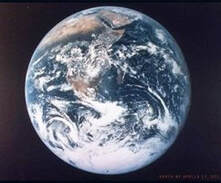
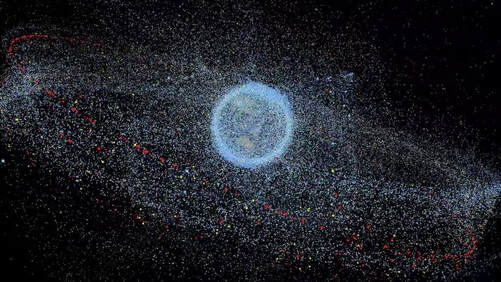
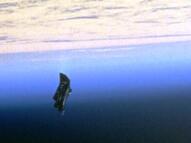
 RSS Feed
RSS Feed